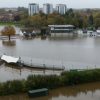In early February, California experienced two consecutive storms fueled by the “pineapple express,” a potent atmospheric river originating near the Hawaiian Islands.
This weather phenomenon, known for its moist air channels, delivered substantial precipitation across the state.
The first storm hit from January 31 to February 1, followed by another from February 4 to 6. Both storms brought significant rain and snow, particularly impacting the region between Santa Barbara and San Diego.
Downtown Los Angeles recorded 10.57 inches of rain by February 7, nearly triple the monthly average and 74% of its annual rainfall.

The severe weather prompted several counties to declare a state of emergency. Flash floods inundated areas, mudslides ravaged hillsides in Los Angeles and San Francisco, and coastal cliffs collapsed in Santa Barbara County. In the Mojave Desert, a major road was washed away, and winds exceeding 100 mph were reported in some regions.
Meanwhile, Nova Scotia also declared a state of emergency due to a storm that left over a foot of snow from Friday to Monday. Cape Breton Island was particularly affected, with Sydney recording 40.6 inches of snow at its airport and nearby areas receiving nearly 60 inches.
Additionally, the EU’s Copernicus Climate Change Service announced that from February 2023 to January 2024, Earth’s average air temperature was 1.52°C above pre-industrial levels, the first time global temperatures have surpassed the 1.5°C threshold for a full year.
Although the 2015 climate pledge aimed to limit warming to 1.5°C, this record does not signify outright failure but increases the urgency of meeting long-term climate goals. The average sea surface temperature also set a new record, reaching 21.05°C, surpassing the previous high of 21.02°C from August 2023.

